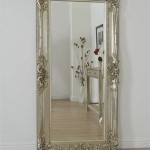Cutting a Mirror: Techniques and Considerations
Cutting a mirror can be a challenging task, requiring precision and a keen understanding of glass handling techniques. While it may seem straightforward, the process involves specific tools and methods to prevent breakage and achieve clean, smooth edges. This article delves into the techniques and considerations involved in cutting a mirror, providing insights for both beginners and experienced glass cutters.
Understanding Mirror Composition
Mirrors consist of a glass substrate coated with a thin layer of reflective material, typically silver or aluminum. This coating is delicate and susceptible to damage during cutting. Therefore, specialized tools and techniques are crucial to avoid scratching or removing the reflective layer. The glass substrate itself can vary in thickness and composition, influencing the difficulty of cutting.
Essential Tools for Cutting a Mirror
To cut a mirror effectively, a dedicated set of tools is essential. These include:
- Glass cutter: A specialized tool equipped with a diamond or carbide wheel for scoring the glass surface. The quality of the glass cutter significantly impacts the smoothness of the cut.
- Straight edge: A long, rigid ruler used as a guide for the glass cutter. This ensures a straight and precise line for the cut.
- Cutting oil: Lubricates the glass cutter and reduces friction during the scoring process. This helps prevent excessive heat buildup and potential damage to the mirror.
- Glass breaking pliers: Designed to apply even pressure along the scored line, separating the glass cleanly. These pliers feature rubber grips to prevent slippage and potential damage to the mirror.
- Safety gear: Gloves to protect hands, eye protection to prevent debris from flying during the cutting process, and a dust mask to filter airborne particles.
Steps Involved in Cutting a Mirror
Cutting a mirror involves a series of precise steps. These steps are outlined below:
1. Preparation
Begin by ensuring a clean and stable work surface. This helps prevent accidents and ensures a smooth cutting process. Lay the mirror on the surface, ensuring it rests flat and secure. If the mirror is large and unwieldy, consider using a support structure to prevent it from shifting during cutting.
2. Scoring the Glass
Using a straight edge as a guide, place the glass cutter at the starting point of the desired cut. Apply firm, even pressure while moving the cutter along the straight edge, creating a score line on the glass surface. Aim for a single, continuous line, avoiding multiple passes over the same area. This prevents chipping or weakening of the glass.
3. Applying Pressure
After scoring the glass, gently apply pressure to the mirror along the scored line. This can be achieved by using a ruler or a piece of wood to push down on the glass surface. The goal is to encourage a clean break at the score line.
4. Breaking the Mirror
Once the glass is scored and pressure is applied, gently bend the mirror along the scored line. This should cause the glass to break cleanly along the score. Be careful not to apply excessive force, as this could lead to a jagged break or the mirror shattering.
5. Cleaning and Finishing
After breaking the mirror, carefully remove any remaining shards. If required, smooth any rough edges using a sanding block or a diamond-coated grinding tool. These tools help create a smooth, polished edge on the cut mirror.
Considerations for Cutting a Mirror
Cutting a mirror requires a degree of skill and attention to detail. To ensure safe and successful cutting, consider the following factors:
1. Safety Precautions
Safety is paramount when working with glass. Always wear protective gear, including gloves, eye protection, and a dust mask. Handle the glass with care, avoiding sudden movements or excessive force. Work in a well-ventilated area to prevent the buildup of dust and debris.
2. Mirror Size and Shape
The size and shape of the mirror influence the complexity of the cutting process. Smaller, rectangular mirrors are relatively easy to cut, while larger or irregularly shaped mirrors pose greater challenges. Be realistic about your skill level and consider professional help if necessary.
3. Glass Thickness
The thickness of the glass substrate can significantly affect the cutting process. Thicker glass requires greater pressure and control during scoring and breaking. Choose a glass cutter and breaking pliers appropriate for the mirror's thickness.
4. Reflective Coating
The reflective coating is delicate and susceptible to damage during cutting. Use a sharp, high-quality glass cutter and avoid applying excessive pressure near the coating to minimize the risk of scratching or removing the reflective layer.

3 Ways To Cut Mirror Wikihow
Gem Mirror Diy Easy Glass Cutting Technique A Beautiful Mess

How To Cut A Mirror Comprehensive Guide

How To Cut Mirror Or Glass

How To Cut A Mirror Or Glass Sawdust Girl

How To Cut Mirror For Diy Mirrored Furniture Salvaged Inspirations

How To Cut Mirror For Diy Mirrored Furniture Salvaged Inspirations

How To Cut A Mirror Without Glass Cutter 13 Steps

How To Cut A Bathroom Mirror In Half Gray House Studio

How To Cut Mirror Or Glass








